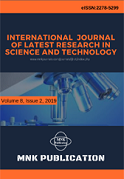DOI:10.29111/ijlrst ISRA Impact Factor:3.35, Peer-reviewed, Open-access Journal
Research Paper Open Access
International Journal of Latest Research in Science and Technology Vol.3 Issue 4, pp 31-36,Year 2014
Correspondence should be addressed to :
Received : 30 July 2014; Accepted : 09 August 2014 ; Published : 31 August 2014

| Download | 125 |
|---|---|
| View | 179 |
| Article No. | 10350 |
This study evaluated the effects of microencapsulation process on different proteins. Insulin, albumin and casein were used as model proteins. Three methodologies to determine protein concentrations were compared: λ 280 nm, Lowry and Bradford colorimetric methods. Proteins were submitted to the first phase of double emulsion method, which is commonly used to produce polymeric delivery systems. Different excipient solutions were tested: NaCl, KSCN, MgCl2 and NaH2PO4 all at 50 mM, PBS and H2O were used as controls. Structural analysis of proteins was performed by SDS-PAGE and intrinsic fluorescence intensities. Results showed direct reading at 280 nm the most suitable for quantitative measures of the three proteins presenting linear coefficient (r2) of 0.9849, 0.9992 and 0.9995 for insulin, albumin and casein, respectively. The excipient solution that allowed greater recovery of proteins was PBS, which recovered 45%, 44% and 90% of albumin, insulin and casein, respectively. For albumin, KSCN solution also enabled recovering 47% of processed protein. Electrophoretic pattern did not revealed fragmentation or aggregation of the three analyzed proteins. Structural analysis of proteins by measuring of intrinsic fluorescence has shown: PBS and NaH2PO4 solutions effectively maintained the integrity of protein structures for albumin, KSCN and MgCl2 solutions for insulin, and PBS solution for casein. Taken all these results together, it was possible to conclude that phosphate-based solutions are best excipients to protect proteins with higher molecular weights or size, and chaotropic salts, such as MgCl2, are the best one to low-molecular weight peptides as insulin.
Copyright © 2014 Reginaldo Almeida da Trindade et al. This is an open access article distributed under the Creative Commons Attribution 4.0 International (CC BY 4.0) license which permits unrestricted use, distribution, and reproduction in any medium, provided the original work is properly cited.
Reginaldo Almeida da Trindade,Ant?nio Carlos Melo Lima-Filho,Mouzarllem Barros dos Reis, Lucas Rodrigues de Carvalho,Paulo Henrique de Holanda Veloso , " Influence Of Different Excipients And Protein Characteristics On Their Susceptibility To Microencapsulation Process ", International Journal of Latest Research in Science and Technology . Vol. 3, Issue 4, pp 31-36 , 2014

MNK Publication was founded in 2012 to upholder revolutionary ideas that would advance the research and practice of business and management. Today, we comply with to advance fresh thinking in latest scientific fields where we think we can make a real difference and growth now also including medical and social care, education,management and engineering.

We offers several opportunities for partnership and tie-up with individual, corporate and organizational level. We are working on the open access platform. Editors, authors, readers, librarians and conference organizer can work together. We are giving open opportunities to all. Our team is always willing to work and collaborate to promote open access publication.

Our Journals provide one of the strongest International open access platform for research communities. Our conference proceeding services provide conference organizers a privileged platform for publishing extended conference papers as journal publications. It is deliberated to disseminate scientific research and to establish long term International collaborations and partnerships with academic communities and conference organizers.